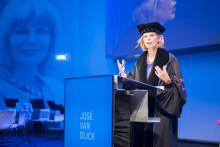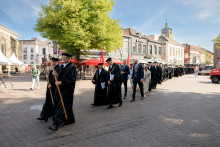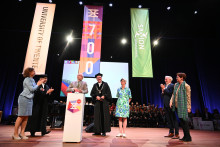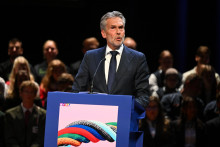José van Dijck is the president of KNAW (Royal Netherlands Academy of Arts and Sciences) and a professor of comparative media studies at the University of Amsterdam. Today she took the stage in the Waaier to give a lecture titled 'When High Tech and Humanities Touch'.
'Everything needs to be human oriented from the start'
According to José van Dijck, it is crucial to couple social sciences with engineering. 'Even the late Steve Jobs said that technology alone isn´t enough, that it is the combination of liberal arts and high tech that makes our heart sing,' said Van Dijck. 'Everything needs to be human oriented from the moment of conception. The first programming languages wouldn´t be possible without the help of linguistics, for instance.'
That is why professor Van Dijck is convinced that humanities scholars and engineers need to work together from the very start. As an example of a promising marriage between the two fields, Van Dijck mentioned a project aiming to develop a better search engine for online video archive, because such a project needs not only technology, but also knowledge of user needs and desires.
Humanities for socially responsible technology
Why else does technology need the humanities? 'Humanities and social scientists are ideal investigators for researching socially responsible engineering. We need to raise questions that go beyond the technology´s conventional use,' explained José van Dijck. 'The second thing that can come out of this intimate relationship between humanities and engineering is a collaborative mindset. The issues we face today are too complex, we need each other to solve them. We need the individual disciplines, but also to absorb each other´s strength. It may take a while to get used to each other's academic language, but the marriage will make our hearts sing.'
Interdisciplinary collaboration on a national scale
One way to launch interdisciplinary collaboration on a large scale is the Dutch National Research Agenda, through which the Dutch academics identified common priorities and research themes. 'It shows that the nation´s scientists are eager to take on the great challenges of the 21st century,' said Van Dijck. 'The national research agenda triggered a series of collective activities and we urge the Dutch government to invest in the collaboratively identified themes. I hope our politicians have the wisdom to realize that young scientists are the best investment.'






